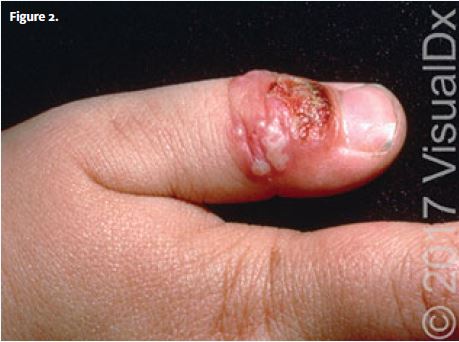Published on
Differential Diagnosis
- Herpetic whitlow
- Mycobacterium marinum infection
- Reactive arthritis
- Spider bite
- Contact dermatitis
Diagnosis
The correct diagnosis is herpetic whitlow, or distal digital herpes simplex virus (HSV). This is an uncommon infection occurring on the fingers or periungually, either from HSV1 or HSV2. In children, herpetic whitlow from HSV1 is more common. Tellingly, it’s also more common in dental and medical personnel who do not regularly wear gloves. Toe involvement from toe sucking has been reported in infants. Digital-to-genital contact of HSV2 is also a mode of transmission.
Learnings
- After an incubation period of 3-7 days, during which there may be local erythema and edema, as well as tenderness, a group of vesicles appears around the perionychium and on the volar digital skin. These may progress to erosions, or may become pustular first and simulate a felon
- Lesions may involve the distal-free edge of the nail and extend into the nail bed, which often results in hemorrhage
- Swelling of the hand with lymphatic streaking may also occur
- Recurrences of herpetic whitlow may be seen, especially in immunosuppressed individuals
Pearls for Urgent Care Management and Consideration for Transfer
- Herpetic whitlow is self-limited, though topical treatments may provide symptomatic relief
- Tense vesicles may be unroofed to help alleviate symptoms
- Antibiotics should not be used except in in cases complicated by bacterial superinfection
A 3-Year-Old with Lesions on His Thumb
1 2

